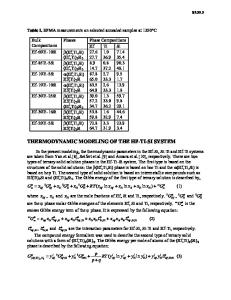Experimental Investigation and Thermodynamic Reassessment of the Cu-Fe-Si System
- PDF / 795,992 Bytes
- 15 Pages / 593.972 x 792 pts Page_size
- 97 Downloads / 330 Views
INTRODUCTION
THE elements Fe and Si are well known for hardening Cu alloys, due to the precipitation of iron silicides.[1] The Cu-Fe-Si ternary system is also one of the typical metal systems in the melting treatment process of domestic waste incineration residue.[2] Moreover, the Cu-Fe-Si system is one of the widely used Cu-Fe–based systems in the fabrication of core-type structural material.[3] In order to optimize alloy composition and control process conditions with an eye toward improving the properties of the multicomponent alloys containing Cu, Fe, and Si elements, an understanding of phase equilibria and thermodynamic properties in the Cu-Fe-Si system is indispensable. Furthermore, a thermodynamic description for the Cu-Fe-Si system is desired within our research project, which is aimed at establishing a precise thermodynamic database for multicomponent Al-based commercial alloys containing Cu, Fe, Mg, Si, etc.,[4–7] via a combined approach of experimental and thermodynamic modeling. The Cu-Fe-Si system has been critically assessed by Jaenecke,[8] Chang et al.,[9] and Villars et al.[10] and was subsequently updated by Raghavan.[11–13] Most recently, Lebrun et al.[14] reviewed almost all the experimental phase diagram and thermodynamic data for the Cu-Fe-Si system. According to Lebrun et al., most of JINGRUI ZHAO, LIJUN ZHANG, and JIANLIE LIANG, Doctoral Candidates, and YONG DU, HONGHUI XU, and BAIYUN HUANG, Professors, are with the State Key Laboratory of Powder Metallurgy, Central South University, Hunan, People’s Republic of China. Contact e-mail: [email protected] Manuscript submitted January 6, 2009. Article published online June 16, 2009 METALLURGICAL AND MATERIALS TRANSACTIONS A
the experiments available in the literature were performed at high temperatures or in the Cu-rich region. Based on their own experimental results, both Ohtani et al.[15] and Hino et al.[2] performed a thermodynamic optimization for this ternary system. However, the Gibbs energy expressions of pure Cu and Si[16,17] used by these authors[2,15] are different from those recommended by the Scientific Group Thermodata Europe (SGTE);[18] in addition, their binary data differ from those currently accepted.[19–21] Subsequently, considering almost all the experimental data available in the literature, Wang et al.[22] and Miettinen[23] conducted a thermodynamic description. Both groups of authors focused on the Cu-Fe side. Although their calculated results are in reasonable agreement with their selected experimental data, as many as four and six ternary parameters are introduced for the descriptions of liquid phase by Wang et al. and Miettinen, respectively. The use of so many parameters is not justified and thus requires confirmation by further experimental evidence, in view of the limited experimental data associated with liquid phase. In addition, the introduction of too many parameters might affect the extrapolated results for high-order systems and even the quality of the thermodynamic database in multicomponent systems.[24] Thus, the
Data Loading...











